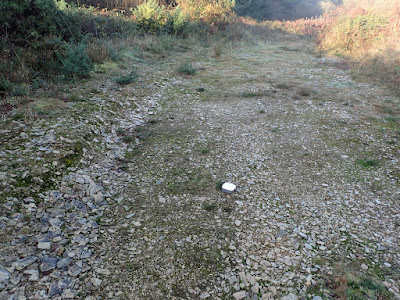Bryophyte Conservation, Petrolhead Style
bike tracks at Glandy Cross
I found my way on to a motocross course near Glandy Cross this week. The tracks here are scraped down to the shale and clay-rich subsoil. The designer created the kind of varied topography that is sorely lacking from conservation management - ridges, puddles, banks with varying slope and aspect - and the seemingly irregular use has allowed bryophytes to thrive. Solenostoma gracillimum and Oligotrichum hercynicum dominate the acidic ground here, the latter with developing capsules which haven't previously been recorded in Pembrokeshire. Less frequent are Diplophyllum obtusifolium, Bryum bornholmense and Ditrichum lineare, the latter representing a third site in the county.
 Oligotrichum
Oligotrichum with developing capsules
 Scattered shoots of Ditrichum lineare were found in 3 places
Scattered shoots of Ditrichum lineare were found in 3 places
A more formal survey on a disused 4x4 course just south of St Clears today also turned up some interest. I was on my knees for around for half an hour before finding what I was half expecting - a good population of Didymodon tomaculosus. Although small, the patches form a distinctly brownish 'understorey' to the taller acrocarps like Barbula unguiculata and Tortula truncata, and are readily recognisable in the field. The landowner duly took the knee and hand lens, and promised to razz about on the quad from time to time. The tracks also held Weissia rutilans and the reedbed here held some Pseudocampylium radicale, a new site for this local speciality.
 Didymodon tomaculosus and location
Didymodon tomaculosus and location





.JPG)

















